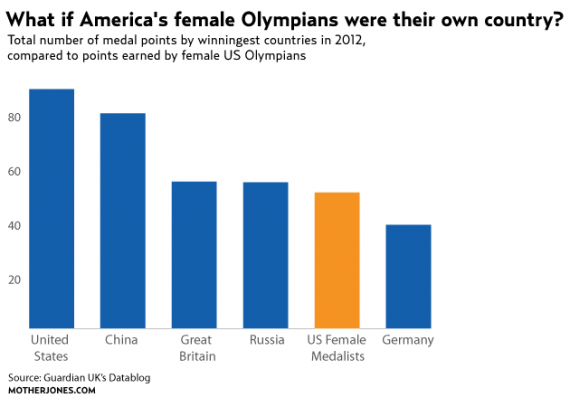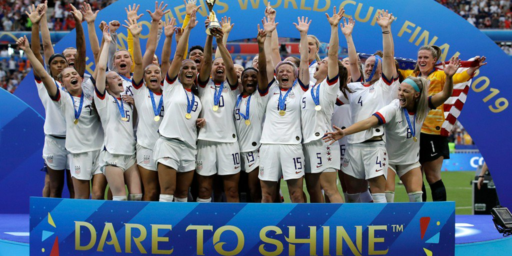US Women Win More Olympic Medals Than All But Three Countries
How dominant were America's women in the London Olympics? They'd have come in fourth place in the medal count in the US sent separate men's and women's teams.
How dominant were America’s women in the London Olympics? They’d have come in fourth place in the medal count in the US sent separate men’s and women’s teams.
Mother Jones (“US Female Olympians Have Won More Medal Points Than All But Four Countries“):
This year, for the first time, the US team sent more women than men to the games: 268 women and 255 men. And the ladies are carrying the American team’s medal tally at this point. Thirty percent of female American athletes have medaled so far, compared to 15 percent of male American athletes.
In fact, if American women were their own country, they’d be fifth in the overall count of medal points right now.
Now, the list is a bit misleading. They’re crediting individual medals for team sports, meaning that they’re giving the US women credit for 11 medals in soccer even though it was a single event. The count would be further inflated had they credited the medals for basketball but the chart was published in the wee hours Sunday morning.
Regardless, it’s an impressive performance. Whereas the American men are still also-rans in soccer, the women’s team has been contenders for Olympic gold and World Cups since the competition opened. And the women’s basketball team is still almost as dominant today as the Dream Team was in 1992. Most countries simply aren’t investing in women’s sports to anything near the degree that the United States has and the results speak for themselves.







@James Joyner:
China and India are the only two countries with a larger population than the United States.
Indonesia, Brazil, Pakistan, Nigeria, Bangladesh, Russia, and Japan have a smaller population than the United States, but their populations are 100+ million plus.
It’s not just about how much money you put into women’s sports, but also about population size.
Countries like Germany, France, Italy, Canada, Norway, New Zealand, etc, may or may not put more money per capita into women’s sports than the United States does, but the population of those countries are so much smaller.
@PJ: There are certainly a lot of factors. India is a virtual non-factor in the Olympics despite a huge population. China, with only slightly more people, is quite dominant. The US probably has the best combination: a large population, most of which is relatively affluent, plus a decades-long tradition of girls and women competing in sports.
Greetings:
I, too, was impressed by the performance of the US Women’s Olympic team, especially the way its members handled the totally objective adjulation of our media. It’s my fervent hope that by the next Olympic Games we can, at the very least, begin doing away with the gender segregation paradigm that has been imposed, over these many generations and in violation of all forms of Muslim and human rights, and allow our women to compete directly against our male athletes or at least the men’s junior varsity team.
@11B40:
“…begin doing away with the gender segregation…and allow our women to compete directly against our male athletes…”
Cut the bull will you. It’s not segregation it’s fairness!
Look at the time-sheets and you will see that men outperform women in every sport where athletic performance is the major factor. (No surprise, it’s biological!)
The exception, equestrian competitions where men and women compete in the same events because …. the athletic part is done by the horse!
Regarding men’s soccer, a better benchmark is the World Cup, because of the way the Olympic rules govern the makeup of the roster. As opposed to the women, who are able to bring their national teams intact, the men’s roster is limited to players under 23 years of age, with three roster exemptions for older players. That is one reason, for example, why the 2010 World Cup champion Spain didn’t even make it out of the first round at the Olympics.
@James Joyner:
Using the same data, from the Guardian datablog (which isn’t complete, since it’s missing the last day of competition, for instance basketball medals aren’t in the data), you’ll also find out that Chinese female athletes:
1. are winning an even bigger share of China’s medals than the US female athletes’ share of US medals
2. have also won more medal points than any country other than the US, China, GB, and Russia
US female athletes has won more medal points than Chinese female athletes though, but not by much.
China doesn’t have an affluent population, nor do they really have a decades-long tradition of girls and women competing in sports.
Well, according to conservatives, gumint can’t do anything good. That means that the consensus that Title IX tremendously helped in the discovery and development of US female athletes must be wrong…..
@stonetools: George Will and others have argued that Title IX was a lagging indicator of a trend rather than the cause of one. That is, we codified into law a societal consensus that girls should get an equal shot at playing sports.
@PJ:
“China doesn’t have an affluent population, nor do they really have a decades-long tradition of girls and women competing in sports. ”
But they do have a massive state sponsored Olympic program that started in the late 1990s when they knew they would host the games in 2008. In other words, they apply the recipe Est-European countries proved to be very successful during the cold war.
@James Joyner:
I honestly have some doubts about that. I think a lot of schools would gladly not spend money on women’s soccer, for example, save for the fact that they need a female team sport to counterbalance men’s football.
@James Joyner:
In China, essentially the entire team is professional atheletes. They do well in sports where they’re competing against true amateur atheletes. In sports where everyone is sending professionals (soccer, tennis, cycling, basketball), China gets its clock cleaned.
@Stormy Dragon:
“… They do well in sports where they’re competing against true amateur atheletes …”
ALL world class gymnasts, swimmers, track & field athletes etc … are professionals.
@Murray:
That’s not technically true, at least in the way that the IOC or NCAA defines the term. Several of the top swimmers, gymnasts, etc. retain their amateur status and continue or go on to compete in the college ranks. It’s true, though, that they all train full time and most get support from the USOC and others to facilitate their training.
@James Joyner:
“…that they all train full time and most get support from the USOC and others to facilitate their training. ”
Which is what I call … professional, as are the Chinese athletes (to go back to SD’s argument)
@James Joyner:
In most countries, the money they get only helps defray the costs of their training. Most olympic atheletes still must work a day job to pay for the remainder, as well as their own living expenses:
http://www.syracuse.com/news/index.ssf/2012/08/little-noticed_olympic_event_h.html
Well what else can he say? Conservative dogma pretty much dictates that response.
When I was a kid, girls did gymnastics, volleyball and badminton seriously, and that was it – but Title IX was starting to take effect and change the landscape. The year after I graduated from high school, the senior class behind mine had a girl who could beat all but a handful of the guys in basketball one on one. Beat them badly. At the time, no one could believe it. Suddenly girls basketball games drew large crowds and got media attention.
Now if a guy watches women’s sports, he will see a lot of women he could not compete with, by a long shot. Considering the huge positive effects of participation in sports on kids, I think we should all be pleased abou teh gubmint intervention that played such a huge part in brining this change about.
In other words, they [China] apply the recipe East-European countries proved to be very successful during the cold war.
Well not quite the same recipe, what with today’s more sophisticated drug testing.